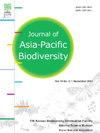Characterization of the plastid and mitochondrial genomes of Aeschynomene indica (Fabaceae)
IF 0.6
Q4 BIODIVERSITY CONSERVATION
引用次数: 0
Abstract
The current study undertook a detailed analysis of both the plastid and mitochondrial genomes (plastome and mitogenome) of Aeschynomene indica (Fabaceae), a plant notable both as a problematic weed in global rice cultivation and for its medicinal properties. The primary goal was to furnish comprehensive organelle genome resources and explore genomic characteristics. A sample of A. indica was collected and sequenced using a next-generation sequencing technique. The resulting plastome is 160,502 base pairs (bp) long and includes 128 genes—comprising 83 protein-coding genes, 37 transfer RNA (tRNA) genes, and eight ribosomal RNA (rRNA) genes. The plastome displays a typical quadripartite structure consisting of a large single-copy region (89,347 bp), a small single-copy region (19,803 bp), and two inverted repeat regions (each 25,676 bp). The mitogenome spans 388,249 bp and contains 57 genes, which include 34 protein-coding genes, 20 tRNA genes, and four rRNA genes. Phylogenetic analyses leveraging these organelle genome sequences produced well-resolved trees, elucidating the phylogenetic position of A. indica within the Fabaceae. The organelle genomes of A. indica presented in this study offer valuable genomic resources that will facilitate further research in plant systematics and biotechnology.
Aeschynomene indica(豆科植物)质粒和线粒体基因组的特征描述
本研究对蚕豆科七叶草(Aeschynomene indica)的质体和线粒体基因组(质体组和有丝分裂基因组)进行了详细分析。七叶草在全球水稻种植中是一种问题杂草,并且具有药用价值。主要目的是提供全面的细胞器基因组资源,探索基因组特征。收集了一份籼稻样本,并采用新一代测序技术对其进行了测序。得到的质体长160502个碱基对(bp),包含128个基因,包括83个蛋白质编码基因、37个转移RNA (tRNA)基因和8个核糖体RNA (rRNA)基因。质体呈现典型的四分体结构,包括一个大的单复制区(89,347 bp),一个小的单复制区(19,803 bp)和两个反向重复区(每个25,676 bp)。有丝分裂基因组全长388,249 bp,包含57个基因,其中包括34个蛋白质编码基因、20个tRNA基因和4个rRNA基因。系统发育分析利用这些细胞器基因组序列产生了很好的树,阐明了A. indica在豆科中的系统发育位置。本研究获得的籼稻细胞器基因组为进一步开展植物分类学和生物技术研究提供了宝贵的基因组资源。
本文章由计算机程序翻译,如有差异,请以英文原文为准。
求助全文
约1分钟内获得全文
求助全文
来源期刊

Journal of Asia-Pacific Biodiversity
Agricultural and Biological Sciences-Insect Science
CiteScore
1.70
自引率
12.50%
发文量
94
审稿时长
27 days
期刊介绍:
The Journal of Asia-Pacific Biodiversity (previous title was Journal of Korean Nature) is an official journal of National Science Museum of Korea (NSMK) and Korea National Arboretum (KNA). The scope of journal is wide and multidisciplinary that publishes original research papers, review articles, as well as conceptual, technical and methodological papers on all aspects of biological diversity-its description, analysis and conservation, and its application by humankind. This wide and multidisciplinary journal aims to provide both scientists and practitioners in conservation theory, policy and management with comprehensive and applicable information. However, papers should not be submitted that deal with microorganisms, except in invited paper. Articles that are focused on the social and economical aspects of biodiversity will be normally not accepted.
 求助内容:
求助内容: 应助结果提醒方式:
应助结果提醒方式:


